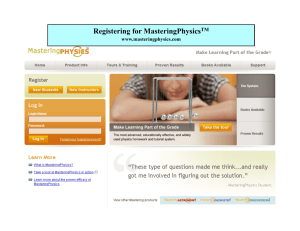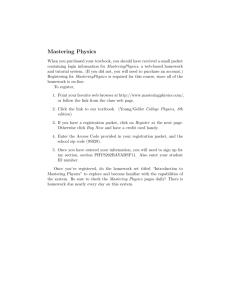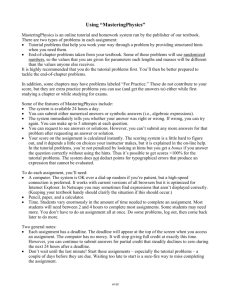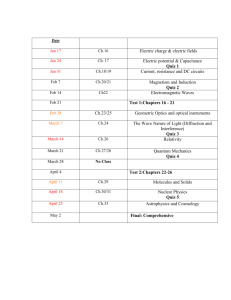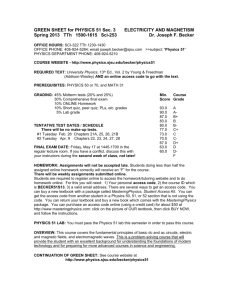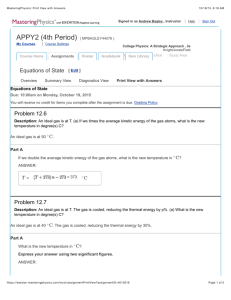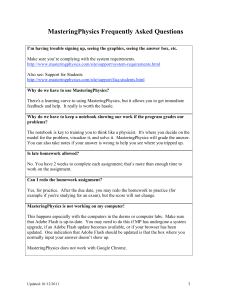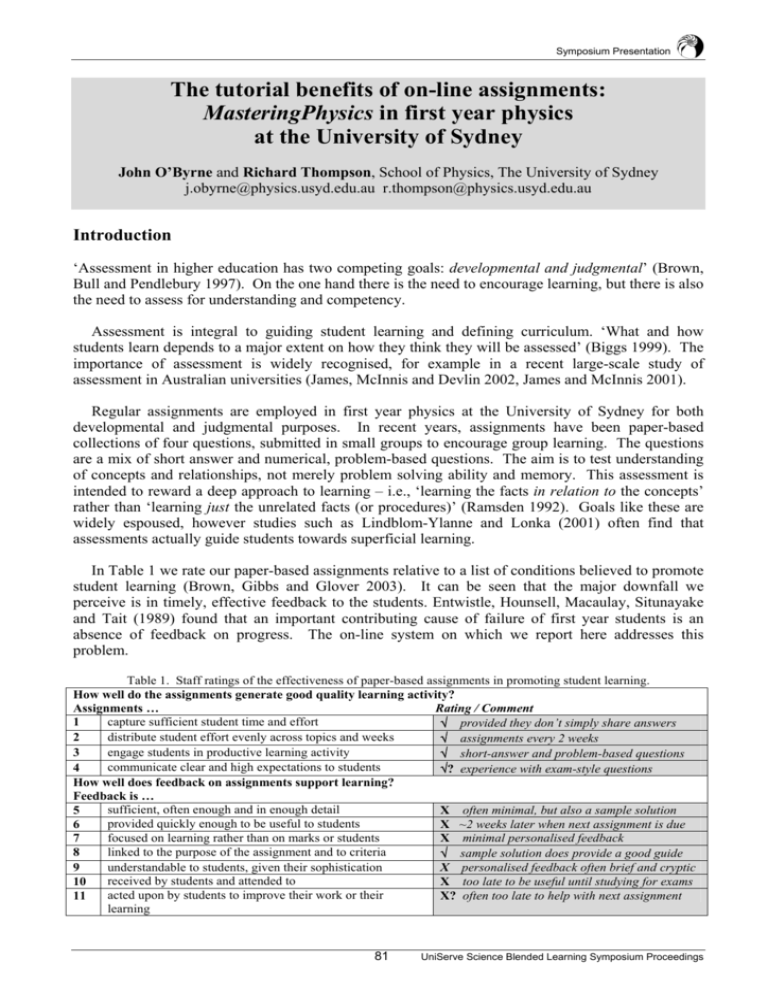
Symposium Presentation
The tutorial benefits of on-line assignments:
MasteringPhysics in first year physics
at the University of Sydney
John O’Byrne and Richard Thompson, School of Physics, The University of Sydney
j.obyrne@physics.usyd.edu.au r.thompson@physics.usyd.edu.au
Introduction
‘Assessment in higher education has two competing goals: developmental and judgmental’ (Brown,
Bull and Pendlebury 1997). On the one hand there is the need to encourage learning, but there is also
the need to assess for understanding and competency.
Assessment is integral to guiding student learning and defining curriculum. ‘What and how
students learn depends to a major extent on how they think they will be assessed’ (Biggs 1999). The
importance of assessment is widely recognised, for example in a recent large-scale study of
assessment in Australian universities (James, McInnis and Devlin 2002, James and McInnis 2001).
Regular assignments are employed in first year physics at the University of Sydney for both
developmental and judgmental purposes. In recent years, assignments have been paper-based
collections of four questions, submitted in small groups to encourage group learning. The questions
are a mix of short answer and numerical, problem-based questions. The aim is to test understanding
of concepts and relationships, not merely problem solving ability and memory. This assessment is
intended to reward a deep approach to learning – i.e., ‘learning the facts in relation to the concepts’
rather than ‘learning just the unrelated facts (or procedures)’ (Ramsden 1992). Goals like these are
widely espoused, however studies such as Lindblom-Ylanne and Lonka (2001) often find that
assessments actually guide students towards superficial learning.
In Table 1 we rate our paper-based assignments relative to a list of conditions believed to promote
student learning (Brown, Gibbs and Glover 2003). It can be seen that the major downfall we
perceive is in timely, effective feedback to the students. Entwistle, Hounsell, Macaulay, Situnayake
and Tait (1989) found that an important contributing cause of failure of first year students is an
absence of feedback on progress. The on-line system on which we report here addresses this
problem.
Table 1. Staff ratings of the effectiveness of paper-based assignments in promoting student learning.
How well do the assignments generate good quality learning activity?
Rating / Comment
Assignments …
capture sufficient student time and effort
1
√ provided they don’t simply share answers
distribute student effort evenly across topics and weeks
2
√ assignments every 2 weeks
engage students in productive learning activity
3
√ short-answer and problem-based questions
communicate clear and high expectations to students
4
√? experience with exam-style questions
How well does feedback on assignments support learning?
Feedback is …
sufficient, often enough and in enough detail
5
X often minimal, but also a sample solution
provided quickly enough to be useful to students
6
X ~2 weeks later when next assignment is due
focused on learning rather than on marks or students
7
X minimal personalised feedback
linked to the purpose of the assignment and to criteria
8
√ sample solution does provide a good guide
understandable to students, given their sophistication
X personalised feedback often brief and cryptic
9
received by students and attended to
10
X too late to be useful until studying for exams
acted upon by students to improve their work or their
11
X? often too late to help with next assignment
learning
81
UniServe Science Blended Learning Symposium Proceedings
Symposium Presentation
What is MasteringPhysics?
In recent years, textbook publishers have offered a variety of CD or web-based materials to
accompany their physics texts. In physics at the University of Sydney we have been reluctant to
integrate electronic materials into our teaching because it is a big step when the benefit to students is
uncertain. We have also been concerned about adding to student workload and imposing
technological and access ‘barriers’ between students and the material.
In July 2003 Pearson/Addison Wesley, publisher of our main first year physics textbook
(University Physics by Young and Freedman, 11th edition), released the MasteringPhysics on-line
tutoring and homework system. MasteringPhysics is an adaption of the CyberTutor system from MIT
(Morote and Pritchard 2002) (Further papers related to MasteringPhysics/CyberTutor are available
from the MIT group at http://relate.mit.edu/publications.html). Other sophisticated systems to assess
complex physics problems are also under development (e.g., see Liew, Shapiro and Smith 2004).
MasteringPhysics is accessed by students through the web (http://www.masteringphysics.com). It
provides questions that use a Socratic dialogue with the student - when they have difficulty in
answering a problem it offers hints or a simpler problem, provides tailored feedback to a wrong
answer and ultimately rewards the student’s method and not just the final answer.
MasteringPhysics offers a variety of advantages over the paper-based assignment system:
• Feedback is immediate, allowing a diligent student to reach the correct answer for each question.
Under the recommended procedures that we adopted, student mark is determined by the number
of incorrect answers submitted and hints used ().
• Marking is immediate, relieving the staff of this task and immediately reporting marks for each
question to staff and the student. A diligent student should get 100% (or more!).
• All students must complete the assignment under their own login, which promises to substantially
reduce copying of assignments and allows us to increase the value of assignments.
The trial at the University of Sydney
The MasteringPhysics system was trialled at the University of Sydney during second semester of
2004 in the PHYS 1003 (Technological) unit of study. This group of approximately 250 students,
mostly from science and engineering degrees, was chosen because problem solving is an important
aspect of their course. Importantly, these students had already completed one semester of physics
using the paper-based assignment system. They could therefore comment on the relative merits of
the two systems from the students’ perspective.
The system was used for six assignments that covered the subject areas of fluids,
electromagnetism and quantum physics. Each assignment consisted of eight questions - two five and
two ten mark ‘assignment’ questions, reflecting the structure of the paper-based assignments, plus
four ‘tutorial’ questions worth just two marks each. These were intended to encourage use of other
tutorial questions provided separately.
To monitor the implementation of the system a small grant was obtained from the University’s
SciFER (Science Faculty Education Research) grant scheme to fund a part-time research assistant
(Thompson), independent of the teaching staff of the unit of study. The aim of this project was to
study the effect of MasteringPhysics on student attitudes and results, in particular in comparison to
the alternative paper-based assignment system. Feedback was obtained from students collectively
using a survey and focus groups, and individually via the MasteringPhysics website or WebCT-based
discussion forum. In addition, marks and participation rates were monitored using the
MasteringPhysics system and other assessment tasks.
UniServe Science Blended Learning Symposium Proceedings
82
Symposium Presentation
Issues arising from the trial
In general, students found the MasteringPhysics environment reliable and easy to use. However, a
number of issues were raised or clarified by the focus groups and the survey.
• Lack of computer access was not a major issue. 95% of students had access to a computer at
home, plus an internet connection (broadband 55%, dial-up 40%)
• Input of equations can be difficult for the novice user, however one goal of the trial was to make
students aware of the strict syntax requirements when using computers in scientific applications.
• Students need to understand the value of using hints - sacrificing the small bonus of not using
them for the larger reward of getting the problem correct!
• Technical problems were remarkably few. Errors or omissions in questions were few and minor
and fed back to the system administrators.
• Copying is minimised but still possible using MasteringPhysics. Students in the focus groups
were not overly concerned because they realised that short term benefits of copying would be
compensated by the reduced tutorial value of the system.
Survey results
Among the survey questions, students were asked several questions about the value of
MasteringPhysics for them. These included:
• Did MasteringPhysics help you in problem solving in physics this semester?
• Did MasteringPhysics help your understanding of concepts in physics this semester?
Three staff members rated each response to these questions on an integral scale from -2 up to +2,
corresponding to ‘significantly negative’, ‘negative’, ‘neutral’, ‘positive’ and ‘significantly positive’.
A combined rating was obtained by rounding the average of the three numerical ratings to the nearest
integer. In general, the ratings agreed extremely well. The outcomes from the analysis, shown in
Table 2, shows that the overall response to MasteringPhysics is clearly positive. It is interesting to
note that the students rated MasteringPhysics slightly higher in helping them understand concepts in
physics than in helping them with problem solving. This was unexpected.
Table 2. Student ratings of the helpfulness of MasteringPhysics in problem solving in physics and
understanding of concepts in physics
MasteringPhysics did not help
MasteringPhysics helped
significantly
negative
negative
neutral
positive
significantly
positive
Problem solving
8%
18%
3%
55%
16%
Understanding
of concepts
3%
16%
2%
67%
12%
We looked for a relationship between the opinion of students about MasteringPhysics and their
final overall results for the unit of study. Student responses were divided into two groups according
to their rating of the value of the MasteringPhysics system for understanding of concepts in physics.
As seen in Figure 1, the mean final mark obtained by the group who thought MasteringPhysics
helped their understanding of concepts in physics is slightly higher than for those who thought it did
not. The number of students in Figure 1(b) is much smaller and a simple t-test yields a p-value = 0.13
that suggests there is little likelihood of a significant difference between the distributions. Any
difference may reflect slight differences in the attitudes or backgrounds of the two groups. Factors
such as gender have been examined but the data do not allow any statistically significant conclusions.
An analysis of the problem solving comments yielded very similar results.
83
UniServe Science Blended Learning Symposium Proceedings
Symposium Presentation
30
7
6
25
Mean final mark = 58.6
Standard error of mean = 2.4
Mean final mark = 62.2
Standard error of mean = 1.1
5
20
4
15
3
10
2
5
1
0
0
20
25
30
35
40
45
50
55
60
65
70
75
80
85
20
25
30
35
40
45
Final Mark
50
55
60
65
70
75
80
85
Final Mark
Figure 1. Final overall results in the unit of study for students who thought MasteringPhysics (a) helped and (b) did not
help their understanding of concepts of physics.
Students were asked at the focus group meetings and in the survey to compare MasteringPhysics
with the paper-based assignments. Comments were varied, ranging from
‘Yes, I learnt more from this system than from the written assignments last semester.’
to
‘No, [it] was a terrible system of learning. Hand written assignments are far superior.’
However, whatever they thought of MasteringPhysics, many of the students had no great love for the
paper-based assignments.
MasteringPhysics as a predictor of examination performance
Proponents of MasteringPhysics claim it can be used to predict examination performance. Our data
are presented in Figure 2, comparing the MasteringPhysics assignment mark versus examination
mark for the students. Clearly this simple correlation is very poor (correlation R2 = 0.07). This is
not surprising given the obvious tendency for students to achieve marks close to 100% on
MasteringPhysics assignments. A more complex multi-variable correlation using factors such as
numbers of correct responses, hints requested, etc. may be more successful. However a lack of good
correlation between in-semester assessment and examination results is typical in our experience.
A further important conclusion is that the 2004 results are not significantly different from 2003
results. MasteringPhysics had no significant impact on student results in the examination.
100
70
90
60
80
Perecentage of Students
70
60
50
40
30
50
40
30
20
20
10
10
0
0
10
20
30
40
50
60
70
80
90
100
110
MasteringPhysics assignment mark (% max)
0
0
1
2
3
4
5
6
7
8
9
10
11
12
13
14
Number of Chapters
Figure 2. Comparison of MasteringPhysics
assignment mark and Examination mark for
the PHYS 1003 class in 2004
Figure 3. Percentage of students attempting some non-compulsory
questions from book chapters covered by MasteringPhysics
UniServe Science Blended Learning Symposium Proceedings
84
Symposium Presentation
Tutorial use of MasteringPhysics
It was hoped that the assignments, with their compulsory tutorial question component, would serve
as a starting point for students to explore more questions in MasteringPhysics. The system kept a
record of student use of these extra questions for the 14 book chapters covered in the unit.
As can be seen from Figure 3, use of this resource was very limited. Over 60% of students did not
use them at all and almost no one used them systematically. For time-poor, assessment-driven
students, perhaps this is not surprising. It simply reproduces previous experience where
recommended but optional extra questions from the text book are rarely attempted by students.
Discussion
As described earlier, the attractions of MasteringPhysics as a teaching aid centred on its ability to
deliver timely and targeted feedback to the students doing the assignments. The system of hints and
the immediate feedback was generally popular with students:
‘Yes, the feedback and hints assist you in the right direction and knowing that your answer is
incorrect right away and getting a second chance is really, really good.’
From a technical point of view, MasteringPhysics performed well and most students adapted to it
without many problems.
Table 3 illustrates our rating of the effectiveness of MasteringPhysics in the Trial against the same
scale used for paper-based assignments in Table 1. Once again these are our perceptions, although in
this case based on student feedback. Comparison with Table 1 emphasises our positive view of the
effectiveness of MasteringPhysics.
Table 3. Staff ratings of the effectiveness of MasteringPhysics assignments in promoting student learning
How well do the assignments generate good quality learning activity?
Rating / Comment
Assignments …
capture sufficient student time and effort
1
√ provided they don’t simply share answers
distribute student effort evenly across topics and weeks
2
√ assignments every 2 weeks
engage students in productive learning activity
3
√? but short answer questions lost
communicate clear and high expectations to students
4
√? but perceived loss of exam-style questions
How well does feedback on assignments support learning?
Feedback is …
sufficient, often enough and in enough detail
5
√ tailored to the student responses
provided quickly enough to be useful to students
6
√ provided when required
focused on learning rather than on marks or students
7
√ 100% possible for many students
linked to the purpose of the assignment and to criteria
8
√ sample solution does provide a good guide
understandable to students, given their sophistication
9
√ tailored to the student responses
received by students and attended to
10
√ used to help answer problems
acted upon by students to improve their work or their learning
11
√? only used to complete the assignments
There were losses in going from paper-based assignments to MasteringPhysics. Short answer
questions cannot be marked by the system. Group work that our paper-based assignments encourage
(in principle) is perhaps discouraged (also in principle) by students working through the
MasteringPhysics questions under their own login name. Students particularly noted the loss of the
close alignment between questions in the paper-based assignments and those in the final
examination. The ‘Skill Builder’ questions used in MasteringPhysics are indeed different, but the
other problems are conceptually similar to examination questions. However only the ‘End of
Chapter’ questions, used for a few MasteringPhysics questions, are like examination questions in
providing no feedback. Does this reflect an assessment-driven attitude where the students use the
feedback simply to complete the assignment questions and don’t see assignment questions as
learning?
85
UniServe Science Blended Learning Symposium Proceedings
Symposium Presentation
An assessment-driven approach to learning is also suggested by the very low usage of optional
tutorial questions. This is not a change however, since only a few students ever find the time to do
extra questions. With most students doing some paid work alongside their university and social
commitments, making time for anything beyond assessment tasks is always an issue. Usage of
MasteringPhysics beyond the compulsory assignments may be easier to encourage if students use it
from the start of their university physics career, as has happened in 2005.
Disappointingly, the adoption of MasteringPhysics did not make a perceptible change in the
performance of students in the final examination, although this is hard to establish without using a
standard examination. This lack of impact occurred despite MasteringPhysics offering students a
clearly better educational approach than the previous paper-based assignments. We suggest that the
students’ assessment-driven approach to learning did not allow them to take real advantage of the
system, in particular by using questions beyond the compulsory assignment. We need to use
MasteringPhysics encourage a new attitude among the students. We need to sell it better and have
attempted to do that in a wider implementation of the system in first semester 2005.
Acknowledgements
This research was supported by a University of Sydney, Faculty of Science SciFER (Science Faculty Education
Research) grant that funds Richard Thompson’s position. We would like to thank the lecturers and students in PHYS
1003 for their cooperation.
References
Biggs, J. (1999) Teaching for Quality Learning at University. Open University Press, Buckingham.
Brown, G., Bull, J. and Pendlebury, M. (1997) Assessing Student Learning in Higher Education. London, Routledge.
Quoted in Lindblom-Ylanne and Lonka (2001).
Brown, E., Gibbs, G. and Glover, C. (2003) Evaluation tools for investigating the impact of assessment regimes on
student
learning.
Bioscience
Education
Electronic
journal,
2,
2-5.
[Online]
Available:
http://www.bioscience.heacademy.ac.uk/journal/vol2/beej-2-5.htm [2005, July 6].
Entwistle, N.J., Hounsell, C.J., Macaulay, C., Situnayake, G. and Tait, H. (1989) The Performance of Electrical
Engineers in Scottish Education. Report to the Scottish Education Department, Centre for Research on Learning and
Instruction Department of Education, Univ. Edinburgh.
James, R. and McInnis, C. (2001) Strategically Re-positioning Student Assessment. Discussion Paper, Centre for the
Study of Higher Education, Melbourne. [Online] Available: http://www.cshe.unimelb.edu.au/downloads/Assess.pdf
[2005, July 6].
James, R., McInnis, C. and Devlin, M. (2002) Assessing Learning in Australian Universities. Centre for the Study of
Higher Education, Melbourne.
Liew, C.W., Shapiro, J.A. and Smith, D.E. (2004) Assessing student performance in solving complex physics problems.
Conference
on
Intelligent
Tutoring
Systems,
September
2004.
[Online]
Available: http://www.physics.rutgers.edu/~shapiro/tutor/its04.pdf [2005, July 6].
Lindblom-Ylanne, S. and Lonka, K. (2001) Students’ Perceptions of Assessment Practices in a Traditional Medical
Curriculum. Advances in Health Sciences Education, 6, 121–140.
Morote, E-S. and Pritchard, D.E. (2002) What course elements correlate with improvement on tests in introductory
Newtonian mechanics? Annual Meeting of the National Association for Research in Science Teaching, New Orleans,
April 6-10.
Ramsden, P. (1992) Learning to Teach in Higher Education. Routledge, London.
© 2005 John O’Byrne and Richard Thompson.
The authors assign to UniServe Science and educational non-profit institutions a non-exclusive licence to use this
document for personal use and in courses of instruction provided that the article is used in full and this copyright
statement is reproduced. The authors also grant a non-exclusive licence to UniServe Science to publish this document on
the Web (prime sites and mirrors) and in printed form within the UniServe Science 2005 Conference proceedings. Any
other usage is prohibited without the express permission of the authors. UniServe Science reserved the right to undertake
editorial changes in regard to formatting, length of paper and consistency.
UniServe Science Blended Learning Symposium Proceedings
86

